September 19, 2003
Air Date: September 19, 2003
FULL SHOW
SEGMENTS
Environmental Injustice
View the page for this story
According to a new study by the U.S. Commission on Civil Rights, government agencies aren't sufficiently considering the impact of policies on minority and low-income communities. Host Steve Curwood discusses the report with commission chair Mary Frances Berry. (05:00)
Living on the Fence Line - Part 1
/ Deepa DondeView the page for this story
When a man returns to his hometown on the Texas Gulf Coast, he's shocked at how dirty the air seems and begins organizing. Port Arthur is home to six of the 500 refineries and industrial plants on Texas's upper Gulf Coast. Independent producer Deepa Donde reports. (08:00)
Living on the Fence Line - Part 2
/ Deepa DondeView the page for this story
Producer Deepa Donde's report on efforts to clean up the air in Port Arthur Texas continues, as she visits long time residents who fear the air may be hurting their health. (12:00)
Emerging Science Note/Super Mammal
/ Cynthia GraberView the page for this story
Living on Earth’s Cynthia Graber reports on the world's largest rodent. (01:15)
Peace Parks
View the page for this story
Countries in political conflict may turn to nature as a reason for opening up their borders. Host Steve Curwood speaks with John Hanks, director of the Southern Africa Transfrontier Conservation Areas, about several peace parks proposed in the recent World Parks Congress. (05:00)
Overflowing Artifacts
/ Ken ShulmanView the page for this story
By law, any public lands set for construction projects or oil or gas exploration must first be open to archaeological examination and, if necessary, excavation. In the Southwest, these excavations are yielding all sorts of historical treasures. But archaeologists and area museums are running out of space to store these artifacts. Ken Shulman has the story. (07:00)
Eating Apes
View the page for this story
The hunting of apes for food is a long-established tradition for certain tribes in the Congo Basin. In recent years, bushmeat has become an increasing source of food for loggers, and a delicacy in some African cities. Host Steve Curwood speaks with Dale Peterson about his book on the bushmeat crisis called "Eating Apes." (08:20)
This week's EarthEar selection
listen /
download
Show Credits and Funders
This Week's Music
Show Transcript
HOST: Steve CurwoodGUESTS: Mary Frances Berry, John Hanks, Dale PetersonREPORTERS: Deepa Donde, Ken ShulmanNOTES: Cynthia Graber
[THEME MUSIC]
CURWOOD: From NPR - this is Living on Earth.
[THEME MUSIC]
CURWOOD: I’m Steve Curwood. The federal government is supposed to protect people from pollution, but if you’re poor, black and living in the petrochemical alley along the Texas Gulf Coast, you’d better hold your breath.
PRINCE: The air is so different. I’ll swear to living God. You pull into Houston, and it’s like oh, I can breathe. You know what I mean? When you get back home, it’s like oh my God, what happened. You can taste it almost, when you hit the air. It’s like poisonous or something, I don’t know, it’s like this real foul stench, you know what I mean. It’s in everything.
KELLEY: We just lost a 15–year-old last month, little girl. She had been living with brain tumors, she been having little small tumors all over head.
CURWOOD: Environmental injustice and more this week on Living on Earth, right after this.
[NPR NEWSCAST]
ANNOUNCER: Support for Living on Earth comes from the National Science Foundation and Stonyfield Farm.
Environmental Injustice
CURWOOD: Welcome to Living on Earth. I’m Steve Curwood.
If you’re black or Latino or just plain poor, you’re more likely to suffer health effects from polluting industries and other environmental hazards in your neighborhood. That’s why President Clinton signed an Executive Order to promote environmental justice nearly a decade ago. But today, according to the United States Commission on Civil Rights, the federal government is not effectively enforcing the measure.
These conclusions are based on a year-long assessment of the Environmental Protection Agency, and the Departments of Housing and Urban Development, the Interior, and Transportation. Mary Frances Berry, who chairs the commission, says she’s concerned these agencies have a long list of deficiencies.
BERRY: In the last few years, they have not made environmental justice a central part of their mission. That is, they do not, in fact, review the impact of decisions that they make on these poor and minority communities when they approve or clear people for certain siting decisions that are made at the local level. They don’t bother to ask the right questions, that’s one thing. The other is there are complaints filed by community groups on behalf of those who are affected by pending decisions, and the complaints are often backlogged without any response to them in a timely fashion.
The other thing is that the agencies don’t often make sure that community groups can participate in giving advice when decisions are made in the way that they’re supposed to. And even when community groups are able to participate, they often don’t have the information. Many of them are under-resourced, they don’t have the experts, and they draw as much information as they can, whereas in the law there are provisions to provide some technical assistance to these groups. And finally, where the agencies fall short is they don’t really analyze and assess their behavior. That is, what are they doing, why are they doing it this way, what are the impacts on the people involved, and how could they do it better?
CURWOOD: What does the Civil Rights Commission believe has been the resulting damage to minority communities in the wake of this failure to fully implement the Executive Order on environmental justice?
BERRY: Well, if you look at the health care disparities that exist among communities of color in this country, in particular, poor people in these communities – and these are disproportionately poor communities, we’re talking about Latinos, African Americans, and Native American Indians – you will see that the illnesses that they suffer from, including asthma and including all kinds or respiratory illnesses, stress, high blood pressure, you name it, all of these illnesses you find disproportionately in those communities.
And the health research, not done for the purposes of environmental justice, but just done on the health issues, document the impact of things like certain kinds of landfills, and toxic waste, and certain sewage disposal processes, as well as even noise. There are big studies now being done on the impact of lots and lots of noise on the health and the stress levels and the blood pressure. What we really are saying is that we ought to equal out these hazards. We know that the price of civilization and the price of progress is to have factories and businesses and all kinds of enterprises, and we, as human beings, also throw up a lot of garbage. But the point is to minimize having a disproportionate impact only on some people, based on how poor they are or what color they happen to be.
CURWOOD: Why do you think that the order issued by President Clinton around environmental justice seems to have such little teeth when it comes to enforcing it?
BERRY: Well, the main thing that the order relied on was leadership on the part of the people in the agencies, and that Bill Clinton and OMB, and other government agencies that have oversight, would hold them accountable, keep their feet to the fire. It is fair to say that since the Clinton administration, no one in the administration since has done that. It is public knowledge that environmental issues are not a major concern of the Bush II administration. In fact, Christie Whitman, when she was at the EPA, articulated her desire to implement the Clinton order and to keep it on the front burner. Well, she’s not there anymore. I noted, even yesterday, there was some statement that Bush made about the environment – pollution – and he sort of added to it some caveat about jobs which he’s concerned about because the unemployment rate, but it has nothing to do with the issue. It’s just throwing up sand and dust in peoples’ eyes. So, there’s an absence of leadership in the political arena, in the administration, on this issue.
CURWOOD: Mary Frances Berry is chairperson of the U.S. Commission on Civil Rights. Thanks for taking this time with me today.
BERRY: Thank you very much.
Living on the Fence Line - Part 1
CURWOOD: People along the Texas-Louisiana Gulf Coast face some big challenges when it comes to sharing a neighborhood with industry. They live alongside the largest concentration of petrochemical plants and oil refineries in the nation. Some five hundred of these facilities run from Houston along the upper Gulf Coast. And unplanned releases of hazardous chemicals are frequent. These accidents have become a way of life for people who, as they call it, live on the fenceline. But not everyone accepts the status quo.
Producer Deepa Donde reports from Port Arthur, Texas.
[COUNTRY MUSIC]
DONDE: Port Arthur, population 58,000, is at the far tip of the Texas coastal marshland, about 90 miles east of Houston. As you approach, signs for Spindletop, the first American oil gusher, and Janis Joplin’s hometown museum pop up on your left.
[BIRDS CHIRPING]
DONDE: Nearer still, plumes of white smoke rise from the treetop – the green wall between the highway and the gulf coast refineries. The plants seem hidden but they have been here since the oil boom at the turn of the 20th century. And so have generations of Port Arthur residents.
KELLEY: See the housing projects over there? That’s where I was born, right there and my grandmother used to walk from there all the way down what we call Dunt Road.
DONDE: Hilton Kelley recently came back to Port Arthur from Hollywood. He had plenty of work there, in film and television, and his Screen Actors Guild card is still current. Kelley says he always knew he wanted to inspire kids with his success. But when he did come back, what struck him was the air.
KELLEY: I grew up looking at an orange sky. I thought it was normal until I moved away, went to California and found out that hey, at night the sky didn’t have to be a bright glowing orange. You didn’t have to smell sulfur all day long.
DONDE: In a freshly pressed shirt and khaki linen shorts, Hilton Kelley stands before a barbed wire fence. It divides some thirty houses from a tank farm, dozens of smokestacks, and a maze of piping.
KELLEY: And you can see the refineries right there, bordering this community.
DONDE: At first, you smell something like burnt matches but then it sharpens. A rotten eggy odor lingers in the heat. Most folks here have gotten used to the smell, including Kelley. That is until he had a conversation with an elderly pastor.
KELLEY: He brought it to my attention by saying, “Son, I understand that you want to start a community center but do you understand how polluted this area really is?” And so he started to give me a breakdown as to really what this town was facing.
DONDE: For the past three years now, Kelley has been trying to persuade residents to organize and demand cleaner air. But he’s found it slow-going.
[CAR SOUNDS]
KELLEY: They don’t understand how these chemicals coming out of these plants – when they talk about so much was released in the upset – they don’t equate that with “Wow, I’m breathing this stuff in. This is why I’m coughing so much or this is why my eyes are constantly watering all day. “
[CAR SOUNDS]
DONDE: He points to the day’s paper.
KELLEY: Two nights ago, they just had a pipeline explosion. I heard it and everything – boom – it was so loud. See how orange the sky is right here? Here it is, front page. “Cause of explosion still under investigation. Natural gas pipeline ruptures.”
DONDE: And two days later, the details are still sketchy.
NEWSCASTER: Good morning everyone, I’m Andrea Bishop. Officials are still trying to figure out what caused that pipeline to leak and explode Tuesday night in Nederland.
DONDE: From June 2002 to June of 2003, there were three hundred and forty upsets or accidents in the Port Arthur area. Among these were fifty-six more serious chemical spills, fires, and explosions, releasing millions of pounds of toxic chemicals such as benzene, tuolene, and xylene.
Frustration over numbers like this have lead Hilton Kelley to seek support from experts, people like Neil Carman, who was an investigator for twelve years at the Texas agency that monitors air quality. What he saw made him angry, so he quit. And now, Carman leads the Lone Star Sierra Club.
CARMAN: Port Arthur is a particularly egregious situation because there are so many poor people of color who are living along the fence line of these large industrial plants, the refineries and the chemical plants. I have been down there on a series of trips over the last 10 to 12 years and it’s been a very frustrating situation.
DONDE: Of the six plants in Port Arthur, only Motiva agreed to speak to us. The Motiva refinery is co-owned by Shell and Saudi Arabian oil. Tracey McMinn is an advisor on government affairs for Shell Oil. She says Motiva has reduced emissions by ten percent. It has also invested $70 million dollars in improvements to the facility, following a consent decree with the federal government. Despite Motiva’s improvements and investments, a few months ago the plant had an upset.
MCMINN: We had an incident. We had a power failure is what happened.
DONDE: Losing power meant losing the steam that dilutes hazardous gases. So the plant had to release undiluted gases to avoid a buildup and explosion.
MCMINN: The wind direction took that smoke over into what’s called the El Vista neighborhood which is one of our neighboring communities over here.
DONDE: McMinn says that within thirty minutes of the upset, Motiva sent out a team of air monitors.
MCMINN: According to our monitors and according to screening levels there is no reason to be concerned. We did hold a community meeting in El Vista and the reason we did that is that we don’t want people to have concerns or issues or fears and feel like they can’t talk to us about it. And we want people to be informed of what’s happening over here because I think in many cases not having information is really when problems arise.
[SAMPLE BAG RATTLING]
DONDE: Kelley, though, has been out gathering his own information with gear he keeps in the trunk of his car.
[SOUND OF VACUUM MOTOR]
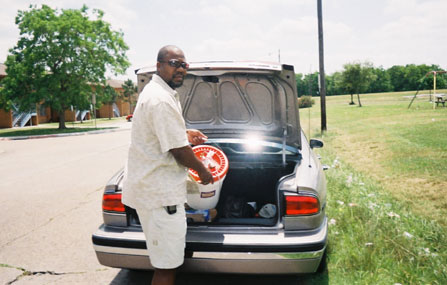 Hilton Kelley takes an air sampling bucket out of his car. (Photo: Deepa Donde)
Hilton Kelley takes an air sampling bucket out of his car. (Photo: Deepa Donde)
DONDE: Using a five-gallon plastic bucket with a vacuum-screw top, Kelley collects a sample in a clear teflon bag. Activists call this the bucket brigade. It’s part of a national grassroots initiative, the Refinery Reform Campaign, to arm citizens with information.
[SOUND OF MOTOR SHUTTING OFF]
DONDE: After he’s collected the sample, Kelley sends it to an independent laboratory in California.
KELLEY: Well, it finds out that there was a big release of benzene in that plume and it was right on this community – and I took the air samples, we got samples to prove it.
DONDE: Analysis of Kelley’s air sample showed levels of benzene that were not high, but were high enough, if sustained, to cause a greater incidence of cancers among residents. Tracey McMinn of Shell Oil stands by her results.
While some gulf coast companies, like Shell, have reduced emissions, others in Texas have been fined stiff penalties for increasing theirs. This May, the Texas attorney general fined Huntsman Petrochemical Corporation close to 9.5 million dollars for releasing more than sixteen million pounds of chemicals from its plant, a few miles from the fenceline. In a rare criminal trial, two of Huntsman’s plant managers were convicted of felonies for lying to the state and EPA. The two are appealing. But one thing is certain. More than thirty years after the passage of the Clean Air Act, many folks along the fenceline are still getting sick.
CURWOOD: Our story about air pollution and the community of Port Arthur, Texas will continue in just a minute. Stay tuned to Living on Earth.
[MUSIC: Tortoise “Six Pack” STANDARDS (Thrill Jockey - 2000)]
Living on the Fence Line - Part 2
CURWOOD: Welcome back to Living on Earth. I’m Steve Curwood.
Much of the nation's gasoline, fertilizer and plastics is manufactured along the southern Gulf Coast. Producer Deepa Donde continues her report now on the Texas community of Port Arthur. The town borders six chemical plants, and it's not uncommon for even young people to face a range of diseases, from respiratory illness to cancer.
[SOUND OF TRAIN]
DONDE: A few miles from the refineries, close to the tracks that used to separate black from white Port Arthur, Hilton Kelley waves to a small thin man at the corner.
[SOUNDS OF CAR PULLING UP, DOG BARKING]
KELLEY: How are you doing?
DOMINIC: All right.
KELLEY: We are going to get out for a minute and meet and greet then we’re going to take a tour. Mr. Dominic this is Deepa.
DOMINIC: Wonderful, wonderful. Close that door.
DONDE: A veteran of World War II and Korea, Reverend Alfred Dominic still holds service on Sunday. He’s the pastor who inspired Hilton Kelley to advocate for clean air, and was one of Port Arthur’s first environmental activists.
DOMINIC: They would never tell us that pollution was here. That all of the Gulf and the Texaco and Atlantic Richfield, at that time, they would never tell us that they were polluting our air. And this is what’s so stifling to me. Why didn’t they tell us? Many of my friends have died with cancer. I am just one of the old dinosaurs and I’m still alive, my wife and I.
DONDE: Reverend Dominic’s concerns for clean air stretch back to Jim Crow times. And he says it gives him peace to pass the torch to Hilton.
DOMINIC: But thank God for this young man. He didn’t, he didn’t wait for nothing; he got out there and saying what he had to say. See, I came up in an era from the 20s on now when they would not allow you to speak. If you would speak they would squash it out. But now, it’s coming to pass that people are speaking out regardless to who you are, what color you are, what country you are from. They are speaking out. And I praise the Lord for that.
[DOG BARKING, FOOTSTEPS]
DONDE: A few houses down lives fifty-year old John Dixon, a former refinery worker.
DIXON: That’s Snoop Dog – some friends of mine give him to me. That’s the name they gave to him, Snoop Dog. You can’t be interviewed so might as well rest.
KELLEY: Did the German Shepherd every have any puppies?
DIXON: Rest, Snoop. Rest. You’re not resting.
DONDE: A picture of Martin Luther King Jr. hangs on his living room wall. But before we have a chance to say much, a young woman walks in to return a fishing pole. She stands cautiously by the door, smoothing her hair.
DIXON: There is a young lady right there – I don’t know if she wants to discuss it but you have a comment. We are on the subject of cancer and environment…hmmm…uterus.
KELLEY: Uterus, you got cancer in the uterus.
DIXON: In the uterus.
WILLIAMS: I just wake up every morning. I’ve got two kids to live for. I have a two-year-old, and I have a four-year-old. A four-year-old, a man. I can’t just lay down on my back and be like “oh well, I’m dying” or something. I just put it in God’s hands – whatever happens, happens. That’s why I don’t claim it all. Everybody has to go from something, so you know.
DONDE: Judy Williams is 21. You’d never know from her broad smile that this woman is a cancer survivor. She found out four years ago, a few weeks after she had her first baby. She thinks that there is something wrong with the air here. She can tell the difference when she drives into Houston, even though Houston has some of the worst air in the country.
WILLIAMS: The air is so different. I mean I’ll swear to living God. You pull into Houston, and it’s like “oh, I can breathe.” You know what I mean. When you get back home, it’s like oh my God, what happened? You can taste it, almost, when you hit the air. It’s in everything.
DONDE: Not a person I met here drinks the tap water. Everyone drinks either distilled or bottled water, including Judy.
WILLIAMS: Ah, yuck!
DONDE: You drink bottled water?
WILLIAMS: Bottled water.
DONDE: You drink bottled water.
WILLIAMS: Bottled water! Honey, you have no idea what’s in this water out here. I mean, people pollute…
DONDE: The mood suddenly shifts to more serious, as Hilton informs Judy about the latest and most forceful of the recent efforts to clean the air in Port Arthur: a class action lawsuit for damages against Premcor, Motiva, Chevron Phillips, Huntsman, BASF, and Atofina.
KELLEY: Because too many young people like yourself is dying from cancer. We just lost a 15-year-old last month, little girl. She had been living with brain tumors. She been having little small tumors all over her head, on the inside, on her brain. She died just last month.
WILLIAMS: Oh my God, who are you talking about?
KELLEY: She was 15 years old. She was 15 years old. She developed brain cancer.
WILLIAMS: I know who you are speaking of.
CARMAN: In a way, you could describe Port Arthur has a kind of Bhopal in slow motion.
DONDE: Again, Neil Carman, president of the Lone Star Sierra Club.
CARMAN: People are being, slowly and systematically, poisoned on a daily basis. And while they may not die today or tomorrow from the insults – from the pollution – they will get cancers and leukemias and brain tumors and kidney failures and so forth from the pollution over the next 10, 15, 20 years.
DONDE: No one has ever conducted a comprehensive survey of Port Arthur’s air or associated health risks. A 1998 study conducted by the Texas Department of Health did show Port Arthur had levels of ozone, hydrogen sulfide, and benzene that suggested a “public health concern” and could pose a risk to the health of residents.
A local toxicologist recently conducted a symptom survey of residents in Port Arthur. More than seventy-five percent had ear/nose/throat problems, respiratory illnesses, muscle and bone diseases, compared to less than a quarter of those in a control group in Galveston.
[HUMMING OF REFINERY]
DONDE: Our last stop is the home of Reverend Dominic’s daughter, Shaza Dominic Prince, a mother of three.
[SOUND OF DOOR OPENING, CLOSING]
DONDE: When I enter, the first thing I notice on her kitchen counter are dozens of medicine bottles and a neatly stacked pile of prescriptions. Next to it lies a portable breathing machine, the kind you see in hospitals.
PRINCE: You clean this out with a little vinegar. We just put this solution, it’s already pre-mixed so we don’t need to add anything to this one, some of the solutions we have to add things…
[SOUND OF NEBULIZER]
DONDE: The nebulizer was a gift from her father to help her children cope with asthma attacks. Shaza herself suffers from chronic pain, earaches, and migraines. On average, she takes twenty pills a day to cope. And last year, the doctors told her she has a degenerative bone disease.
PRINCE: I think that the problem is stemming from a lot of the inhalation of different chemicals and what not that is causing it to deteriorate so fast. Now, it might have been caused by something else, I’m not saying the plant caused it, but I think the deterioration is caused by a lot of the chemicals I’m inhaling and digesting and whatever.
DONDE: Just then, Shaza’s oldest daughter Temisha walks in.
PRINCE: Look, she’s all clogged up now.
TEMISHA: I’m always sick, everyday.
DONDE: Why?
TEMISHA: Huh?
DONDE: Your nose?
TEMISHA: My sinus and congestion and everything – well, it cleared up but when I moved back here about a month ago, I’ve been sick everyday.
DONDE: Temisha takes breathing treatments twice a day. Cullen, her eleven-year old brother, stands quietly in the corner watching us closely, holding a basketball.
PRINCE: You wanna show her a couple of hoops? He wants to be a basketball star, I think his cousin was one.
DONDE: Cullen is the one that Shaza spends her time worrying about most, because his asthma is the worst in the family.
PRINCE: I mean, the first couple years of his life he didn’t even know what the outside looked like, I don’t think. We couldn’t let him go out there, because every time he went outside he got sick. You know, it’s ridiculous.
DONDE: But tonight is a good night. And Cullen’s doing what he loves best, playing basketball.
[BASKETBALL SOUNDS]
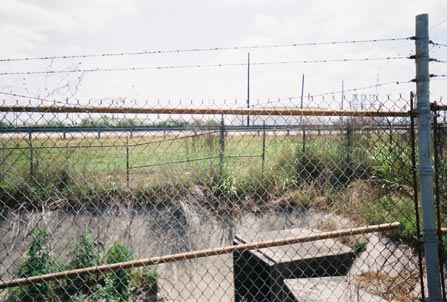 (Photo: Deepa Donde)
(Photo: Deepa Donde)
DONDE: There is a slight orange glow from the refinery across the street. They live at the last house on Foley, the closest to the fenceline. Cullen’s five-year old cousin Mariah runs circles around him.
[CHEERING]
DONDE: Mariah’s wide smile and carefree skip touches anyone who nears her. Shaza whispers that the child came to live with her, a year ago, just after her mom died of uterine cancer at the age of twenty-one.
Shaza has signed her family onto the class action lawsuit filed against the six plants that border her property. But some environmental advocates don’t believe a lawsuit can solve all Port Arthur’s problems. A few have argued for the relocation of Port Arthur residents. That’s what happened to a small group of residents in Norco, Louisiana, about two hundred and fifty miles from Port Arthur.
But many longtime residents like Shaza don’t want to relocate. She hopes that the refineries and petrochemical plants can simply do a better job.
PRINCE: I don’t want them to go away. Like I said, I have a brother that works right out there, out there, and he’s been working there forever. I want him to get his retirement out of them. I don’t want them to go away. I want them to control their emissions so that we can live safely here. That’s what I want.
[SOUNDS OF FAMILY OUTSIDE]
DONDE: It’s nighttime now at the Dominic Prince residence. The children gather close to form a circle.
CULLEN: We want to pray for all the people here, Lord. We want to make sure they wake up tomorrow, Lord, and have another great day like today was. Forgive us for our sins and all the sins that other people have done, amen.
DONDE: In Port Arthur, Texas, I’m Deepa Donde for Living on Earth.
[MUSIC: Jimi Hendrix “Once I Had a Woman” JIMI BLUES (MCA-1994)]
Emerging Science Note/Super Mammal
CURWOOD: Coming up: environmental protection and national security. The promise of peace parks. First, this Note on Emerging Science from Cynthia Graber.
[SCIENCE NOTE THEME]
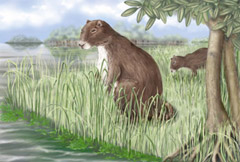 An artist's rendering of Phoberomys pattersoni, a giant rodent, roughly the size of a buffalo, that roamed the banks of an ancient Venezuelan river some 8 million years ago. The illustration was made according to the scientists’ approximation of what P. pattersoni looked like. (Credit: © Science / Illustration: Carin L. Cain)
GRABER: Scientists recently identified the world’s biggest guinea pig. The rodent called Phoberomys pattersoni lived about eight million years ago along the banks of a massive Venezuelan river that has since run dry. At about 1500 pounds, this guinea pig was roughly as large as today’s buffalo. An artist's rendering of Phoberomys pattersoni, a giant rodent, roughly the size of a buffalo, that roamed the banks of an ancient Venezuelan river some 8 million years ago. The illustration was made according to the scientists’ approximation of what P. pattersoni looked like. (Credit: © Science / Illustration: Carin L. Cain)
GRABER: Scientists recently identified the world’s biggest guinea pig. The rodent called Phoberomys pattersoni lived about eight million years ago along the banks of a massive Venezuelan river that has since run dry. At about 1500 pounds, this guinea pig was roughly as large as today’s buffalo.
Scientists describe it as a huge, strange-looking creature, with a long tail so it could balance on its bent hind legs, and constantly growing teeth. No one knows why the rodent reached this immense size, or why it disappeared. But scientists say it gives a new glimpse into life along ancient tropical South American Rivers.
|

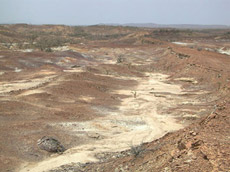 Fossiliferous exposures of the formation found in the town of Urumaco, Venezuela. (Photo courtesy of Marcelo R. Sánchez-Villagra)
Fossiliferous exposures of the formation found in the town of Urumaco, Venezuela. (Photo courtesy of Marcelo R. Sánchez-Villagra) 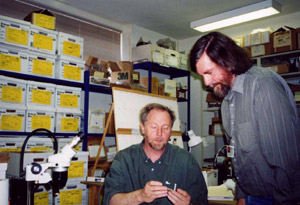 Jim Moore (right) discusses findings from the Pojoaque corridor with a researcher. (Photo: Ken Shulman)
Jim Moore (right) discusses findings from the Pojoaque corridor with a researcher. (Photo: Ken Shulman) 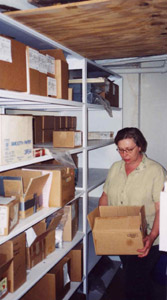 Julia Clifton with a box of artifacts in the Museum of Indian Arts and Culture. (Photo: Ken Shulman)
Julia Clifton with a box of artifacts in the Museum of Indian Arts and Culture. (Photo: Ken Shulman)




